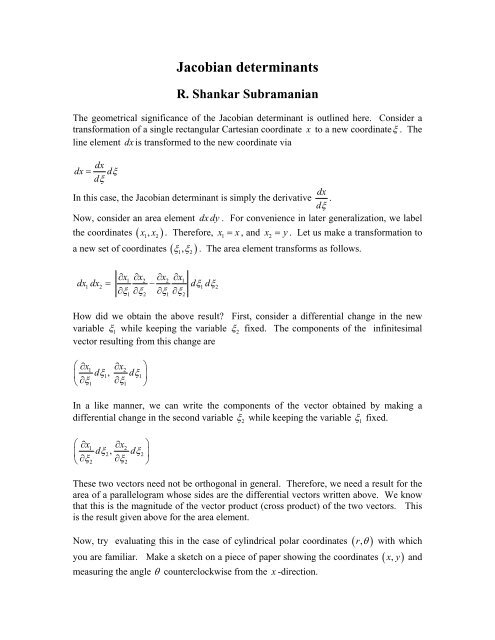Jacobian Determinant
Jacobian Determinant
Jacobian Determinant
You also want an ePaper? Increase the reach of your titles
YUMPU automatically turns print PDFs into web optimized ePapers that Google loves.
<strong>Jacobian</strong> determinants<br />
R. Shankar Subramanian<br />
The geometrical significance of the <strong>Jacobian</strong> determinant is outlined here. Consider a<br />
transformation of a single rectangular Cartesian coordinate x to a new coordinateξ . The<br />
line element dx is transformed to the new coordinate via<br />
dx<br />
dx = dξ<br />
dξ<br />
dx<br />
In this case, the <strong>Jacobian</strong> determinant is simply the derivative .<br />
dξ<br />
Now, consider an area element dx dy . For convenience in later generalization, we label<br />
the coordinates<br />
( 1 2<br />
x , x ). Therefore, x1<br />
a new set of coordinates ( ξ , ξ )<br />
1 2<br />
= x , and x2<br />
= y . Let us make a transformation to<br />
. The area element transforms as follows.<br />
∂x ∂x ∂x ∂x<br />
dx dx = − dξ<br />
dξ<br />
1 2 2 1<br />
1 2 1 2<br />
∂ξ1 ∂ξ2 ∂ξ1 ∂ξ2<br />
How did we obtain the above result First, consider a differential change in the new<br />
variable ξ<br />
1<br />
while keeping the variable ξ 2<br />
fixed. The components of the infinitesimal<br />
vector resulting from this change are<br />
⎛ ∂x<br />
⎜ dξ<br />
,<br />
⎝∂ξ<br />
∂x<br />
⎞<br />
dξ<br />
⎟<br />
⎠<br />
1 2<br />
1 1<br />
1<br />
∂ξ1<br />
In a like manner, we can write the components of the vector obtained by making a<br />
differential change in the second variable ξ<br />
2<br />
while keeping the variable ξ<br />
1<br />
fixed.<br />
⎛ ∂x<br />
∂x<br />
⎜ dξ<br />
,<br />
⎝∂ξ<br />
⎞<br />
dξ<br />
⎟<br />
⎠<br />
1 2<br />
2 2<br />
2<br />
∂ξ2<br />
These two vectors need not be orthogonal in general. Therefore, we need a result for the<br />
area of a parallelogram whose sides are the differential vectors written above. We know<br />
that this is the magnitude of the vector product (cross product) of the two vectors. This<br />
is the result given above for the area element.<br />
Now, try evaluating this in the case of cylindrical polar coordinates ( r , θ ) with which<br />
you are familiar. Make a sketch on a piece of paper showing the coordinates ( ) , x y and<br />
measuring the angle θ counterclockwise from the x -direction.
Let ξ<br />
1<br />
= r and ξ2<br />
= θ . Therefore,<br />
x1 = x= rcosθ = ξ1cosξ2<br />
x2 = y = rsinθ = ξ1sinξ2<br />
Then the vector obtained by making a differential change dξ 1<br />
= dr has components<br />
( dr cos θ , dr sinθ ), where I have placed dr in front of each term for clarity. Similarly,<br />
the vector obtained by a differential change in the polar angle, which is dξ2<br />
= dθ<br />
, has<br />
components ( −rsin θ dθ, rcosθ<br />
d θ ). From your sketch, verify that indeed these are the<br />
correct components.<br />
The extension to three dimensions is straightforward. We make differential displacements<br />
in the three coordinates ξ 1<br />
, ξ 2<br />
and ξ 3<br />
. We write the components of the infinitesimal<br />
vectors so obtained as<br />
⎛ ∂x<br />
∂x<br />
∂x<br />
⎜<br />
⎝∂ξ ∂ξ ∂ξ<br />
1 2<br />
3<br />
dξ1, dξ1,<br />
dξ<br />
1<br />
1 1 1<br />
⎞<br />
⎟<br />
⎠<br />
⎛ ∂x1 ∂x2<br />
∂x<br />
⎞<br />
3<br />
⎜ dξ2, dξ2,<br />
dξ2⎟<br />
⎝∂ξ2 ∂ξ2 ∂ξ2<br />
⎠<br />
⎛ ∂x1 ∂x2<br />
∂x<br />
⎞<br />
3<br />
⎜ dξ3, dξ3,<br />
dξ3⎟<br />
⎝∂ξ3 ∂ξ3 ∂ξ3<br />
⎠<br />
The volume of the parallelepiped formed with these three vectors as its sides is given by<br />
the magnitude of the triple scalar product, which is the absolute value of the determinant<br />
formed by the components of the vectors. From this, by taking out the common factor<br />
dξ1dξ2dξ 3<br />
, we find that the volume dV is given by<br />
( , , )<br />
dV = dx dx dx = J ξ ξ ξ dξ dξ dξ<br />
=<br />
1 2 3 1 2 3 1 2 3<br />
∂x1 ∂x1 ∂x1<br />
∂ξ ∂ξ ∂ξ<br />
1 2<br />
∂x2 ∂x2 ∂x2<br />
∂ξ ∂ξ ∂ξ<br />
1 2<br />
∂x3 ∂x3 ∂x3<br />
∂ξ ∂ξ ∂ξ<br />
1 2<br />
3<br />
3<br />
3<br />
dξ 1 dξ 2 dξ 3<br />
where the inner set of vertical lines stands for the determinant, and the outer set is needed<br />
to yield the absolute value.

















